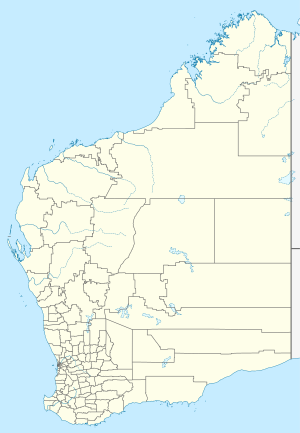Carronade Island lies off the northern (Kimberley) coast of Western Australia (13°56′42″S 126°36′09″E / 13.94500°S 126.60250°E), in Napier Broome Bay. It owes its name to two swivel guns found there in 1916, mistakenly described at the time as carronades.
In July 1916, the Royal Australian Navy cruiser HMAS Encounter entered Napier Broome Bay. On a small island in the bay, a party from the ship found two bronze cannons, protruding from the ground and placed about six feet apart.[1]
The two bronze guns, of different bore and design but both about one metre in length, were removed to Garden Island Naval dockyard.[2] They were initially interpreted as "part of the armament of a Spanish or Portuguese caravel,"[3] a claim also made by writer Kenneth McIntyre in 1977. McIntyre cited the guns as evidence for his theory of Portuguese discovery of Australia and described the cannons as "the most tangible extant link with the first European discovery of Australia".[4]
A detailed report by Jeremy Green of the Western Australian Museum identified both of the weapons as swivel guns. Using metallurgical examination, including X-ray and chemical analysis, the guns have been identified as of late 18th century South East Asian origin and likely to have arrived through Makassan contact with Australia. The claim that the more decorated gun displays a Portuguese "rose and crown" is incorrect.[1][5]
See also
editReferences
edit- ^ a b Green, Jeremy, N: The Carronade Island Guns and South East Asian Gun Founding.[Fremantle, W.A.]: Dept. of Maritime Archaeology, Western Australian Maritime Museum,[2007]. Report No.215 "Archived copy" (PDF). Archived from the original (PDF) on 3 December 2013. Retrieved 30 April 2012.
{{cite web}}: CS1 maint: archived copy as title (link) - ^ Photos of the guns on display in the 1930s at Garden Island can be seen in the National Library of Australia E.W.Searle Photo collection [1] The more ornate of the guns is now on display at the Fremantle Maritime Museum, part of Western Australian Museum. The gun carriages are a 20th century addition.
- ^ Captain Robins, RAN, 1917, correspondence cited in Fitzgerald, L (1984) Java La Grande. The Publishers, Hobart. p.118 ISBN 0 949325 007
- ^ McIntyre, K.(1977) The Secret Discovery of Australia: Portuguese ventures 200 years before Captain Cook. P 81-83. Souvenir Press, Medindie, South Australia. ISBN 0 285 62303 6
- ^ Green, Jeremy N. An investigation of one of the bronze guns from Carronade Island, Western Australia[Fremantle, W.A.] : Dept. of Maritime Archaeology, Western Australian Maritime Museum,[2004].Report no. 180."Archived copy" (PDF). Archived from the original (PDF) on 3 December 2013. Retrieved 1 April 2012.
{{cite web}}: CS1 maint: archived copy as title (link)
- Green, Jeremy N. The Carronade Island guns and Australia's early visitors. Great circle, Vol.4, no.1 (1982), p.73-83.
